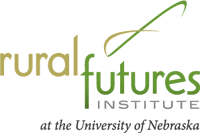
Rural Futures Institute: Publications
Date of this Version
8-2-2017
Document Type
Article
Abstract
Conclusion
Rural Nebraskans purchase their food from a variety of stores. Almost four in ten buy most of their food from a supercenter (like Wal-Mart or Costco). Just over three in ten typically shop at a supermarket and just under three in ten buy most of their food at a small grocery store. Differences in the type of store most utilized occur by community size. Persons living in or near larger communities are more likely than persons living in or near smaller communities to purchase the majority of their food from either a supermarket or supercenter.
Persons living in or near mid-sized communities (populations ranging from 1,000 to 4,999) are the group most likely to purchase most of their food from a small grocery store. This size of community is most likely to be able to sustain a grocery store but not be a target for a supermarket or supercenter. Thus, local grocery stores do maintain market share in communities which are large enough for them to be viable, but too small to be major markets.
Rural Nebraskans are most concerned with the quality, cost and selection of food as well as store characteristics such as cleanliness and customer service when selecting where they shop for food. These characteristics rate higher than location. Most rural Nebraskans shop for food at least once a week.
Rural Nebraskans report being satisfied with most items at the store from which they purchase most of their food, although satisfaction with cost consistently ranks lower than quality or selection across major food categories.
Most rural Nebraskans are within 30 minutes of the store where they do most of their food shopping. However, persons living in or near larger communities are more likely than persons living in or near smaller communities to be within 10 minutes of the store from where they purchase most of their food. Most rural Nebraskans have options for their food shopping.
Most rural Nebraskans have a corner/convenience store closer than the store where they normally shop for food as well as a general merchandise store (like Dollar General or Family Dollar). Almost one-half have a small grocery store closer to them than the store where they normally do most of their food shopping. Almost two-thirds of persons who normally buy most of their food from a supercenter say they have a small grocery store closer to them. Only six percent of persons who purchase most of their food from a small grocery store say there is a supercenter closer to them and only five percent have a supermarket closer.
Beyond retail shopping, rural Nebraskans do utilize other sources for foods. Most rural Nebraskans get at least some of their food from a garden and many get some of their food from a farmer’s market or CSA (community supported agriculture).
Included in
Agriculture Commons, Arts and Humanities Commons, Business Commons, Education Commons, Engineering Commons, Medicine and Health Sciences Commons, Social and Behavioral Sciences Commons


Comments
Copyright 2017, the authors. Used by permission.
Funding for this project was provided by the Cooperative Extension Division of the Institute for Agriculture and Natural Resources, the Agricultural Research Division of the Institute for Agriculture and Natural Resources, and the Department of Agricultural Economics. Additionally, in-kind support was provided by the University of Nebraska Rural Futures Institute.